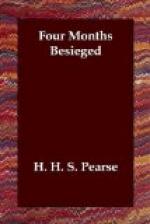When Joubert’s artillery began shelling the town their fire was directed on important stores, the locality of which could only have been indicated to them by secret agents, and on places where officers are known to assemble at certain hours. These may all have been merely strange coincidences, but, at any rate, they are noteworthy as showing that in some way, whether by accident or cunning design, General Joubert’s gunners were able to profit by the truce that was agreed upon without any exact stipulation on either side as to its duration. The tacit understanding seems to have been that both forces should have time to collect their wounded and bury their dead.
It is certain that the Boers took a little more time than was necessary for this purpose, and turned it to good use for themselves by strengthening the earthworks behind which “Long Tom” is mounted, while we in turn were enabled to get a second naval gun of heavy calibre into position before the bombardment began again. The necessity for doing this was probably chief among reasons which kept our artillery silent during the last two days, though it seemed to mere spectators that a chance was thus being given for the enemy to mount batteries on heights that commanded nearly every part of our camp.
To make this perfectly clear without the aid of a map showing contours of all ridges and hollows is very difficult, and one can only attempt to give in words a rough idea of the general position. If the reader will bear in mind what a horse’s hoof inverted looks like, he may get a mental picture of Ladysmith and its surroundings—the heels of the horse-shoe pointing eastward, where, five miles off, is the long, flat top of steep Bulwaan, like the huge bar of a gigantic horse-shoe magnet.




